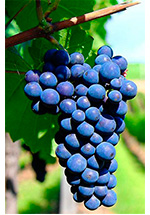



The "Sanserino" is the result of the vinification of Aglianico and Sangiovese grapes, grown in our vineyards. It 'a red wine, light, lively and aromatic drink slightly chilled.
Red wine that present us one beautiful ruby red color with good brightness.
The aroma it’s attractive with hints of sour cherry, blackberries, prunes with a slight presence of sweet spices and a closure of aromatic vegetal notes.
In the palate it’s a red wine soft with a pleasant note of concentrated fruit, balanced, with a long and slightly almond finish.
Wonderful wine for pairing with first courses, sausages, roast pork, vegetarian dishes served with rich and tasty sauces, delicately spicy recipes.

Delivery: 2 to 6 weeks

Delivers all over the world by truck, air and sea. In LCL or full container.

Shelf Life / Products Validity: We always deliver with the maximum validity.
Grapes: 70% Aglianico, 30% Sangiovese
Vineyards in the hilly area extending over the municipalities of Luogosano, S'Angelo All'Esca and Taurasi.
Altitude: 300 m s.l.m.
Silty and sandy and frequent presence of limestone and volcanic elements.
Grapes harvested by hand are de-stemmed and then cold macerated for a few hours.
Then follows maceration on the skins for a week and a refinement of at least 16 months in cement tanks.
Finally, it is refined at least 4 months in the bottle.

Color: ruby red with good brightness.
Aroma: attractive with hints of sour cherry, blackberries, prunes with a slight presence of sweet spices and a closure of aromatic vegetal notes.
Taste: the taste is soft with a pleasant note of concentrated fruit, balanced, with a long and slightly almond finish.
Wine to pair with vigorous first courses, sausages, roast pork, vegetarian dishes served with rich and tasty sauces, delicately spicy recipes.
Best served at a temperature of 12 ° C / 14 ° C.
 Aglianico is a red wine grape variety native to southern Italy. It is known to produce full-bodied red wines that show musky berry flavors with firm tannins and good aging potential. Even when grown in hot climates, Aglianico is capable of reaching high levels of acidity, which makes it a particularly useful vine in the Mediterranean.
Aglianico is a red wine grape variety native to southern Italy. It is known to produce full-bodied red wines that show musky berry flavors with firm tannins and good aging potential. Even when grown in hot climates, Aglianico is capable of reaching high levels of acidity, which makes it a particularly useful vine in the Mediterranean.
The structure and richness of Aglianico make it a popular grape for blending in southern Italy. In Campania, it is frequently blended with Cabernet Sauvignon and Merlot in the production of some IGT wines. Further east in Basilicata, the sole DOC wine in the region, Aglianico del Vulture, is produced from Aglianico grapes grown on the volcanic slopes of Monte Vulture.
In their youth Aglianico wines tend to be very tannic and concentrated, especially if adverse weather conditions force producers to harvest their crop before it has achieved complete ripeness. A few years of aging has a favorable impact on the wine and helps the tannins to soften and the fruit profile to emerge. Aglianico wines are typically garnet-red, fading to terracotta tones after sufficient time in bottle.
Aglianico vines prefer warm, dry conditions, and therefore the grape has been trialed in California and Riverina, Australia. It ripens late even in these warm climates, with the best examples offering aromas of chocolate and plum.
Grape also known as Agliatica, Ellenico, Ellanico, Gnanico and Uva Nera.
 Sangiovese (or Nielluccio in Corsica), a dark-berried vine, is the most widely planted grape variety in Italy. Virtually synonymous with the red wines of Tuscany, and all the romanticism that goes with the territory, Sangiovese is the core constituent in some of the great names in Italian wine. Italy's love affair with Sangiovese – and indeed the world's – is generations old, though recent grapevine research suggests the variety is not as ancient as once thought.
Sangiovese (or Nielluccio in Corsica), a dark-berried vine, is the most widely planted grape variety in Italy. Virtually synonymous with the red wines of Tuscany, and all the romanticism that goes with the territory, Sangiovese is the core constituent in some of the great names in Italian wine. Italy's love affair with Sangiovese – and indeed the world's – is generations old, though recent grapevine research suggests the variety is not as ancient as once thought.
At the dawn of the 21st Century, Sangiovese equated to roughly one in every 10 vines on the Italian peninsula. The quality of Sangiovese wine can be notoriously variable but, in the 1980s, drastically improved winemaking techniques saw a significant shift toward more quality-oriented releases. Sangiovese has numerous clones and is consequently known by many synonyms in its native Italy.
Good-quality Sangiovese is prized for its high acid, firm tannins and balanced nature. Savory flavors of dark cherries and black stone fruit are characteristic, and may be backed by secondary notes of tomato leaf and dried herbs. The use of oak has become more popular and this coaxes richer flavors from the grapes, tending toward plum and wild raspberry.
Sangiovese is widely planted in Tuscany, Lazio, Campania, Umbria, Marche and Corsica.
All clones of Sangiovese are relatively slow ripening, which results in an extended growing season and richer, stronger and longer-lived wines than those made from early-ripening varieties. When the vines are encouraged to produce higher yields, the wine's naturally high acidity is accentuated and its characteristic color noticeably diluted. Further difficulties are experienced because of the grape's thin skin, which makes it susceptible to rot in damp conditions.
Grape also known as Nielluccio, Sangioveto, Sangiovese Grosso, Sangiovese Piccolo, Brunello, Prugnolo Gentile, Morellino.

Data sheet